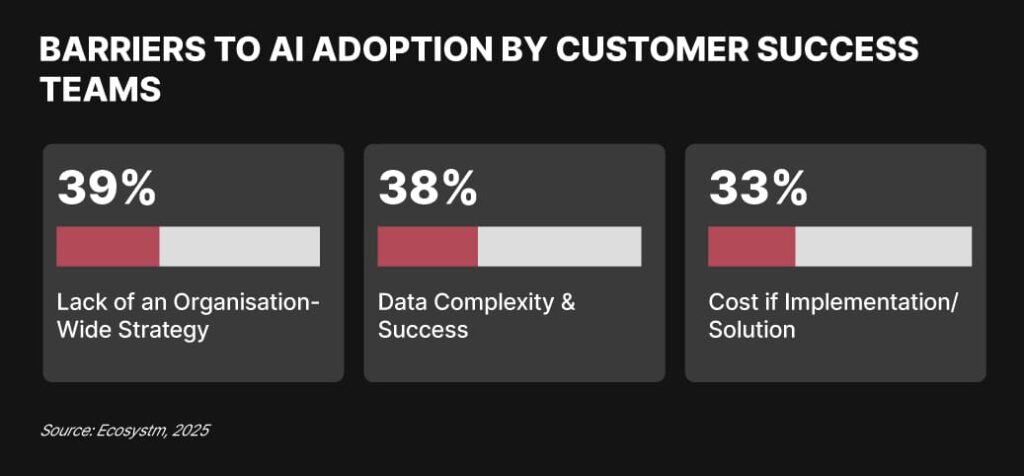Customer Success has moved beyond being a reactive, support-driven function – it now sits at the heart of growth, retention, and lifetime value. As customer expectations grow and pressure mounts to do more with less, AI is increasingly being seen as a solution to scale efficiently while maintaining high levels of personalisation.
Yet despite the promise, few Customer Success leaders feel they’re truly capitalising on AI’s potential. Siloed data, fragmented processes, and low confidence in solution fit are major blockers. What’s needed isn’t just another AI tool – it’s a strategic reset. One where leaders embed AI into the core of how customer teams operate, engages, and deliver value.
The Reality Check: Why AI Stalls in Customer Success
AI adoption in customer teams – whether Sales, Marketing, or Customer Experience – is often slower than expected – not due to lack of interest, but because of persistent structural barriers. Many teams operate without a clear AI strategy, leading to scattered efforts and unclear goals.
Data remains another hurdle. Fragmented systems and limited access make it difficult to generate meaningful, real-time insights. Internal friction over data ownership, lack of alignment between front-end tools and back-end systems, and fragmented infrastructure all create barriers. Add to that the high perceived cost of implementation – spanning tools, training, and integration – and momentum stalls quickly.
Beyond these, cultural resistance and unclear ownership of AI initiatives also contribute. Without alignment across the multiple teams and leadership, even the best-intended AI projects struggle to gain traction.

Beyond Implementation: Empowering Customer Success in AI Strategy
Customer Success leaders are increasingly pivotal in driving AI adoption, particularly given that nearly 40% of current AI initiatives aim to enhance customer success outcomes.
However, their current level of involvement, with only 19% defining use cases and a mere 10% influencing customer data governance, suggests they are not yet engaged enough in shaping these critical AI strategies and roadmaps. While 38% of Customer Success teams are involved in implementing and managing AI solutions, their limited influence in the initial strategic phases means that the AI being deployed may not fully align with the most pressing customer needs.
To truly capitalise on AI’s potential to elevate customer success, these leaders must transition from primarily implementers to active architects of AI strategy, ensuring that AI initiatives are laser-focused on delivering genuine value to customers and the business.
Moving with Intention: Navigating the AI Journey
Despite the hurdles, Customer Success leaders are not standing still. Instead of waiting for perfect conditions, many are reworking their data foundations, building cross-functional alignment, and starting small with high-impact AI use cases. They’re focusing on what they can control – breaking large transformation efforts into phased, measurable steps.
For example, some are prioritising pilot programs within onboarding or escalation workflows to prove quick wins. Others are forming internal working groups with IT, sales, and product teams to align on data strategy and AI tooling. This collaborative, iterative approach is helping reduce resistance and build confidence across the organisation.

This kind of pragmatic, people-first approach is what will help Customer Success teams to not just adopt AI – but embed it into how they deliver long-term value.
The Customer Success Leader’s AI Guide
To move from AI interest to AI impact, leaders need a focused, business-first approach. Here is how they can navigate that shift:
- Map AI to the customer journey. Identify the key pain points – onboarding, escalation, renewal – where AI can have the most visible impact. When use cases are aligned to customer outcomes, adoption naturally follows.
- Fix the foundation first. No AI system can deliver if it’s built on fragmented or low-quality data. Take time to unify and clean your customer data so AI models can generate insights that are timely, relevant, and trusted by your teams.
- Invest in people, not just platforms. AI implementation succeeds when teams understand what’s changing and why. Provide ongoing training, show how AI helps – not replaces – and involve frontline users in pilot programs to build ownership and trust.
- Prioritise clarity over complexity. With 68% of leaders confused by AI vendor claims, it’s critical to strip away jargon and focus on what really matters: ease of integration, use-case alignment, and measurable value. Don’t let complexity stall momentum.
Leading with Intent: Where AI Meets Customer-Centric Growth
The opportunity for Customer Success leaders is no longer just to respond to churn risks or triage support tickets. With AI, they can reimagine how teams scale, how customer journeys are personalised, and how insights are turned into proactive action.
But to realise that vision, leadership must go beyond tool selection. They need to champion a mindset shift, where AI is part of a broader transformation in how success is delivered, measured, and sustained. That means breaking down silos, aligning AI with meaningful metrics, and embedding it seamlessly into workflows, not on top of them.
Ultimately, the goal isn’t to adopt AI for the sake of innovation – it’s to make customer outcomes more human, responsive, and strategic. AI becomes not just a technology initiative, but a business advantage.


